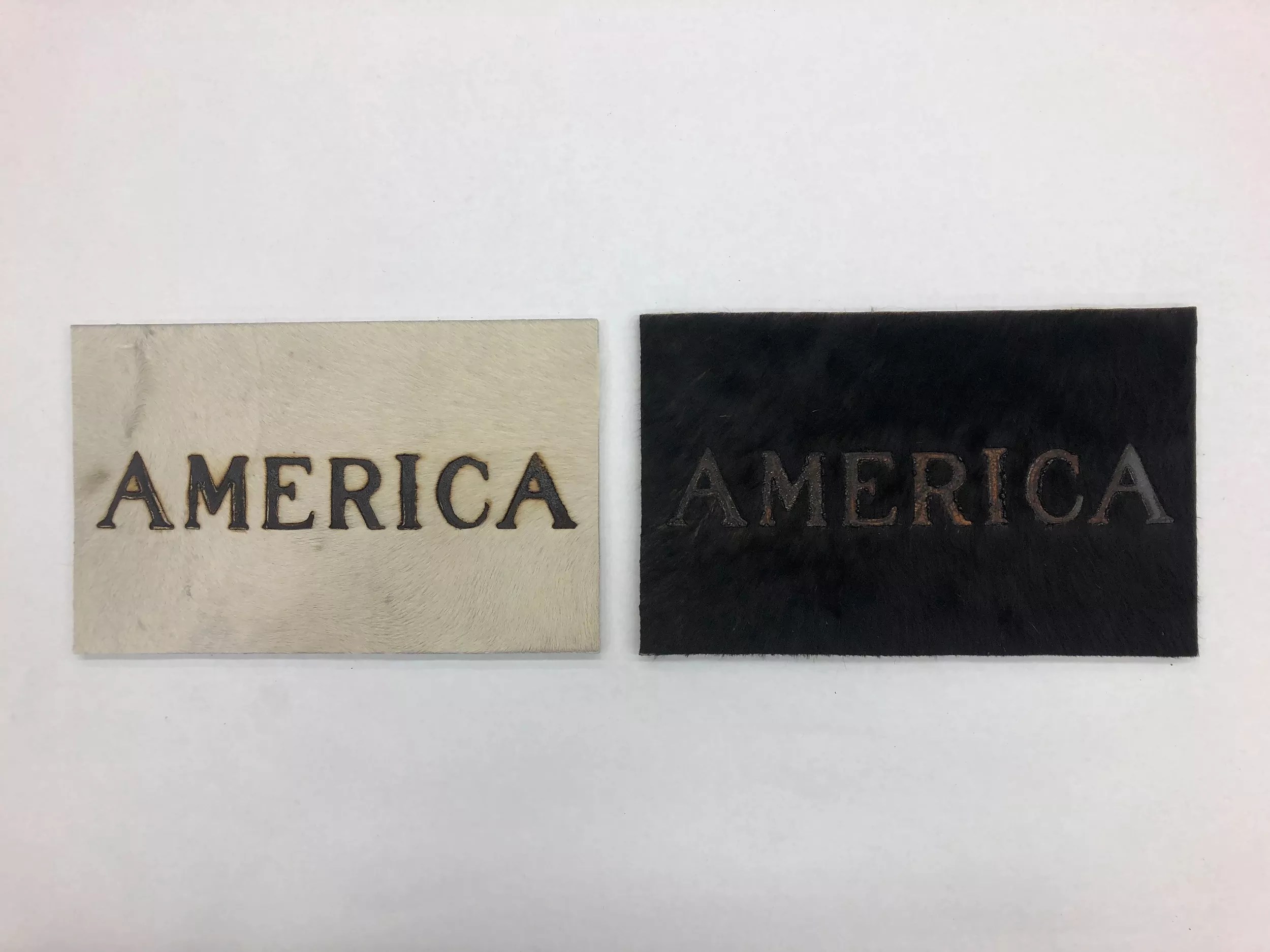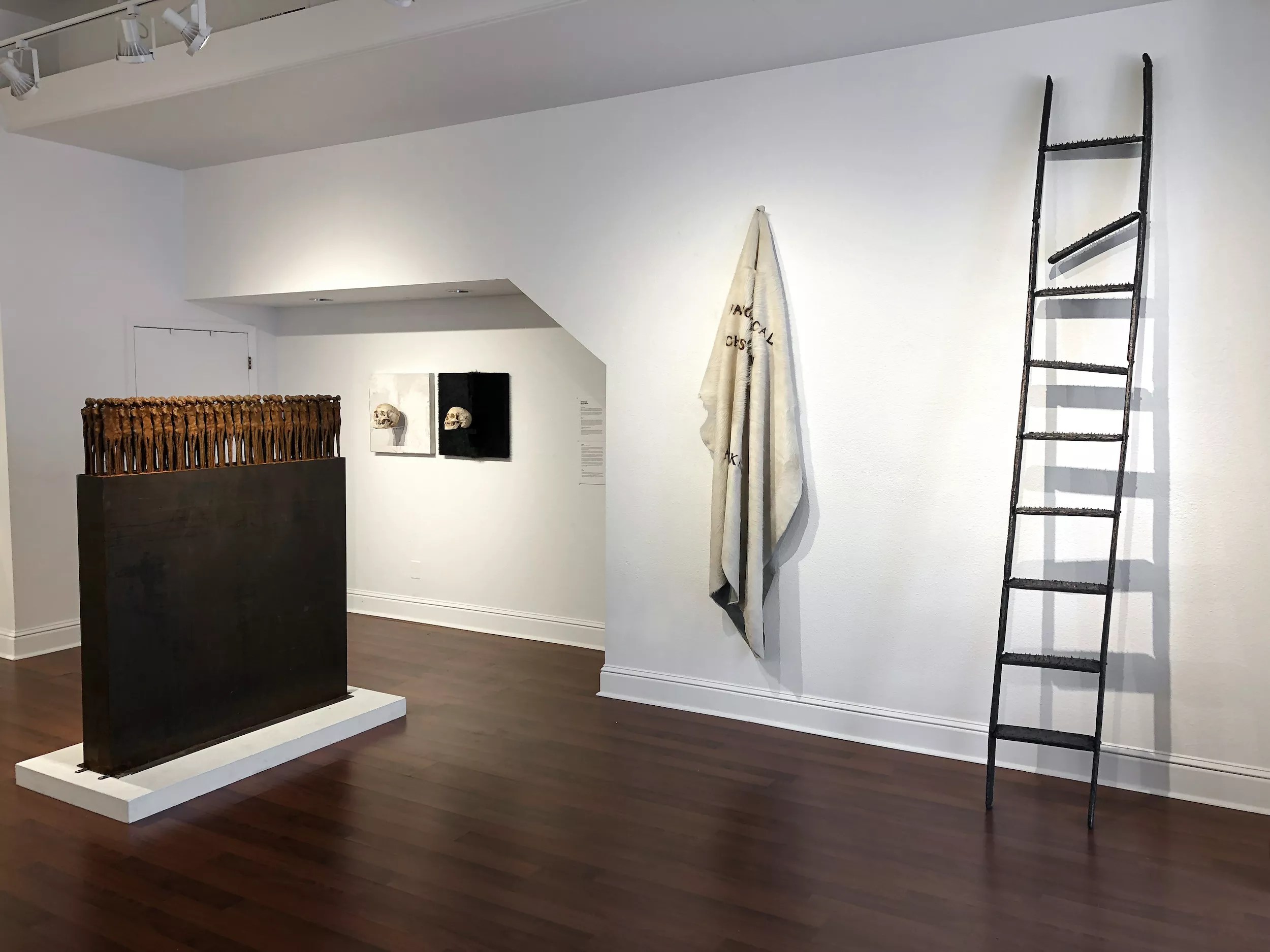
Courtesy of Emmanuel Gallery

Audio By Carbonatix
Michael Brohman uses bronze sculpture to make frank conceptual installations infused with unsettling imagery and themes of inequality and social justice. A longtime and now former member of the Pirate: Contemporary Art co-op, Brohman has put on memorable shows at that space that have twice been named in Westword‘s Best of Denver issues – in 2013 and 2015. He teaches sculpture at the University of Colorado Denver while raising a daughter and making his own work.
Brohman talks about that work, what moves him and inspires him, and his place in the milieu of Denver’s art community as he tackles the Colorado Creatives questionnaire.

Michael Brohman with
Courtesy of Emmanuel Gallery
Westword: What (or who) is your creative muse?
Michael Brohman: I try to find inspiration and lessons from almost everything I encounter, but there are some ever-present influences that routinely direct me.
I was raised on a small farm in rural Indiana until I was thirteen years old. I constantly find myself going back to that formative place as a source for my art. The landscape, the solitude, the quiet progression of cycles and their transformations all factor into my work, as do the natural materials that I encountered on the farm. I make huge leaps as an artist each time I return to the countryside for extended periods of time, where I find myself without a studio or shop equipment. I feel free and open when I am out of the city. I am tempted to say that it is leaving my comfort zone that frees me, but I think it is more appropriate to say that it is returning to my comfort zone that frees me.
My six-year-old daughter, Cricket, is the other source of inspiration. I love experiencing her world and sharing mine with her, and it is really just a whole lot of fun hanging out together. She brings a life to my art practice that I often felt was lacking in the past. She constantly asks me to make up stories, which is frequently exhausting but works my imagination in unusual ways. Having a child brings a focus on time – both the passage of time and the issue of time management. Time taunts me on a daily basis. It continues to pass no matter what happens, and it only gives me 24 hours each day. I have to make the most of each moment, and I now focus on quality of work over quantity. I no longer feel rushed to complete works and am secure enough with my studio practice to not feel as if I always have to create the next best thing. I allow my works the time they need to become complete.
Another thing that guides my work is privilege, and how that single word and all of the entitlements that come with it has shaped me and my life view. It is a powerful realization that has affected my artistic practice and the decisions that guide what subject matters I will take on. I feel a great sense of responsibility for the narratives that are contained within works that I put out into the world.

Michael Brohman,
Michael Brohman
Which three people, dead or alive, would you like to invite to your next party, and why?
Only one person: my mother. She recently died, and the loss is still very raw. All I want is to have one last day with her by myself. No other guests. Just the two of us. When you are part of a large family, relationships are always intertwined. I always had to share her with others, but there are moments of time when it was just us. She was supportive of me and my art in every way possible, from my earliest childhood all the way up to the present. My last conversation with her was shortly before she died, and she called me while I was in my studio working on a particularly troublesome sculpture. She didn’t always like my work, especially some of my early works, but she always encouraged me and appreciated my efforts. She would simply say, “I like some of your work better than others,” and leave it at that. She was always present for me. She was strong, patient and quite private. I think I inherited that sense of privacy from her and try to find a balance of public/private in my life.
What’s the best thing about the local creative community in your field – and the worst?
There are so many exciting opportunities that are occurring in Denver right now, but I think that I go back to something that we have always had: co-operative art galleries. I was fortunate enough to have had representation in a commercial gallery when I first started out as an artist, but it wasn’t until I became a member of a co-operative art gallery that I made substantial advancements as an artist. Pirate: Contemporary Art will always have a special place in my heart for the opportunities it provided me and countless others. Co-ops are what each artist makes of them, so they really teach you how to make, curate and install an exhibition.
I used to love installing my shows at Pirate and then standing back and taking it all in with a sense of accomplishment. I am optimistic that the co-operative galleries will find creative ways to survive in the current rea estate market. Some of the highest-quality works are shown at co-ops, and they give artists the much-needed start to their careers in an art community that at times may be exclusionary.
As for the worst, I think that there are always good and bad in any field, and the bad will change and be replaced by something different. I don’t have anything bad to point out. It is more of pet peeve sort of observation. I find that a lot of work often gets shown in galleries that is experimental and still not fully developed but presented as if it were completed. The experiment oftentimes seems to be stopped midway in its development, and I often feel as though I am looking at a material process, a thought process or something that needs to go further. I think that these experimental works are a vital part of an artist’s personal growth, and I love seeing experimental work that is carried through to its completion, but I am not sure that everything an artist does needs to be or deserves to be labeled as art and then shown. Some things need to be thrown away, recycled or reworked.

Michael Brohman,
Michael Brohman
What’s your dream project?
I always dreamed of being an artist from the earliest time I can remember, so in a sense I think that I am already living my dream. For the past 24 years, I have taught sculpture at the University of Colorado Denver, which allows me to continue to be in a creative and ever-changing environment. I had the opportunity several years ago to buy a studio space, which is a rarity in Denver. All of that is fantastic. What is not part of my dream is all of the non-art-making aspects that come into play with being an artist and making a living. All of my work is self-funded, so I have to create budgets and plan out how to be able to afford my materials. My dream project is to find wonderful homes for all of the works that I have in storage. I tend to make, show, store, and then move on to the next project – in that order. Much of the work that I produce is large and heavy, and my studio is a time capsule of my artistic history. I would love to have an assistant to take the time to market me and my work in a much better capacity than I do myself.
Denver (or Colorado), love it or leave it? What keeps you here – or makes you want to leave?
Probably the hardest question to answer, and it is a common discussion in our household. I honestly have to say that I love it, and at the same time want to flee from it and not look back. I think that this could just be a time in my life where I am evaluating my options and decisions for the second half of my life, and figuring out where, exactly, I fit in. A post-midlife crisis of sorts. Denver gives an abundance of opportunities, but at the same time it demands a lot in return. I am not sure if I am in a symbiotic relationship with Denver – or a parasitic relationship. It is a daily teeter-totter of decisions balancing the positives and the negatives. I have a young daughter, and she is the primary consideration in all my future decision-making.

Gallery shot of Michael Brohman
Michael Brohman
Who is your favorite Colorado Creative?
I have tremendous respect for any individual who is struggling and sacrificing to make art. It is easy to create art when you are receiving validation and recognition for your efforts. It is laudable when you continue to make your art when you do not have emotional or financial support in your vision. These individuals who find ways to keep making their art are my heroes.
Who do you think will (or should) get noticed in the local arts community in the coming year?
There are two individuals whose art practices and work ethics I respect. I have been aware of them for a quite a while, and I follow their work closely. The first is Sharifa Moore. She is an amazing photographer and sculptor, and is chief curator of Arts and Education at the Center for the Arts Evergreen.
The second is Scottie Burgess. He is a sculptor and digital artist, and is a member of Pirate Contemporary Art. He does pretty stunning sculptures with simple materials. He recently had an exhibition at Pirate Contemporary Art, and it is the strongest work I have seen shown in quite a long time.

Michael Brohman,
Michael Brohman
What’s on your agenda in the coming year?
I will have a solo exhibition at the University of Southern Mississippi in early 2021. I will show some of my more challenging pieces in both scale and subject matter, and I will be a guest artist on the campus. I am also currently developing an online three-dimensional design class for the University of Colorado Denver that I will teach in the fall semester in addition to my regular studio classes.
On a personal-growth front, I plan to make a long overdue return to working in clay. I studied ceramics for many years under Richard DeVore, who was the biggest artistic influence on me, and I stepped away from it early in my career for what I thought would be a short time, but it has ended up being over two decades. Richard once told me that I could always return to ceramics when I was ready, and I am now finally ready. My other art-related goal is to learn how to sew. My daughter has a sewing machine, and I want to learn alongside her. It is something that I have always wanted to do but have never taken the time to learn. I want to stitch things together.
Learn more about Michael Brohman online.